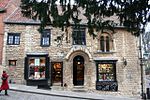Lincoln Castle

Lincoln Castle is a major medieval castle constructed in Lincoln, England, during the late 11th century by William the Conqueror on the site of a pre-existing Roman fortress. The castle is unusual in that it has two mottes. It is one of only two such castles in the country, the other being at Lewes in East Sussex. Lincoln Castle remained in use as a prison and court into modern times and is one of the better preserved castles in England; the Crown Courts continue to this day. It is open to the public most days of the week and possible to walk around the walls from which there are views of the castle complex, cathedral, the city, and surrounding countryside. Displayed within the castle is one of only four surviving exemplars of the Magna Carta of 1215. The castle is now owned by Lincolnshire County Council and is a scheduled monument.
Excerpt from the Wikipedia article Lincoln Castle (License: CC BY-SA 3.0, Authors, Images).Lincoln Castle
West Gate Bridge, Lincoln New Boultham
Geographical coordinates (GPS) Address External links Nearby Places Show on map
Geographical coordinates (GPS)
| Latitude | Longitude |
|---|---|
| N 53.23529 ° | E -0.54095 ° |
Address
Lincoln Castle
West Gate Bridge
LN1 3BJ Lincoln, New Boultham
England, United Kingdom
Open on Google Maps











